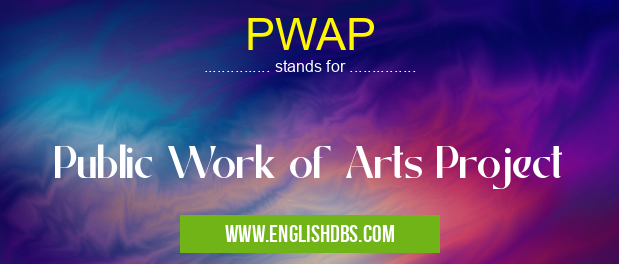What does PWAP mean in ART
PWAP (Public Works of Art Project) was an American government initiative during the Great Depression that employed artists and artisans to create public art. The program was part of the Works Progress Administration (WPA), a broader relief effort that provided jobs for millions of unemployed Americans.

PWAP meaning in Art in Community
PWAP mostly used in an acronym Art in Category Community that means Public Work of Arts Project
Shorthand: PWAP,
Full Form: Public Work of Arts Project
For more information of "Public Work of Arts Project", see the section below.
What is PWAP?
The PWAP was established in 1933 and ran until 1934. During that time, it hired over 3,500 artists who created a wide range of works, including murals, sculptures, paintings, prints, and posters. These works were often displayed in public buildings, schools, libraries, and other community spaces.
Key Features of the PWAP
- Artists' Employment: The PWAP provided much-needed employment for artists who were struggling during the Depression.
- Public Art Creation: The program resulted in the creation of a significant body of public art that continues to be enjoyed by communities across the United States.
- Community Involvement: The PWAP encouraged collaboration between artists and local communities, ensuring that the art created reflected the values and experiences of the people it served.
Essential Questions and Answers on Public Work of Arts Project in "COMMUNITY»ART"
What is the Public Works of Art Project (PWAP)?
The PWAP was a New Deal program established in 1933 as part of Franklin D. Roosevelt's effort to combat unemployment during the Great Depression. It provided work for artists and craftspeople by funding the creation of public artworks.
What types of projects were funded by the PWAP?
PWAP-funded projects included murals, sculptures, paintings, prints, and other forms of public art. These artworks were often installed in schools, hospitals, post offices, and other public buildings across the United States.
Who was eligible to participate in the PWAP?
Artists and craftspeople of all ages and experience levels were eligible to apply for PWAP projects. Preference was given to artists who had been unemployed for an extended period of time.
How were PWAP projects selected?
A jury of artists and art experts reviewed applications and selected projects based on their artistic merit, public appeal, and feasibility.
What was the impact of the PWAP?
The PWAP provided employment for thousands of artists and craftspeople during the Great Depression. It also helped to establish a legacy of public art in the United States. Many PWAP-funded artworks can still be seen in public buildings today.
Final Words: The PWAP was a vital part of the American government's response to the Great Depression. It not only provided employment for artists but also enriched countless communities with beautiful and meaningful public art. The program's legacy continues to inspire artists and communities today.
PWAP also stands for: |
|
| All stands for PWAP |
